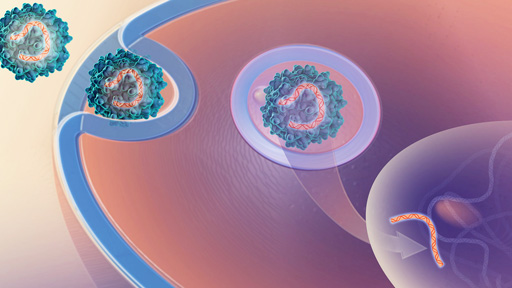Gaucher disease is an inherited condition caused by alterations in the GBA gene. It affects one in every 50,000 to 100,000 people, but is more common in people of Ashkenazi Jewish ancestry. There are three types of the disease: Type 1 causes enlargement of the liver and spleen, a low number of red blood cells, easy bruising caused by a decreased blood platelets, lung disease, and bone abnormalities such as bone pain, fractures and arthritis. The less common Types 2 and 3 affect the central nervous system and can cause abnormal eye movements, seizures and brain damage. Current treatments often involve enzyme replacement infusions, administered intravenously on a regular basis. However, this infused form of the enzyme cannot cross into the brain and treat the symptoms of the disease that affect the central nervous system.
The disease can also cause a damaging build-up of a fatty substance called glucocerebroside in the liver, spleen, bone marrow and nervous system. The main type of cell that is affected by accumulated glucocerebroside is the macrophage, a type of white blood cell. Macrophages are cellular housekeepers that dispose of cell debris and pathogens.
According to the study, researchers found two ways to generate macrophages in culture media. First, they succeeded in generating macrophages from the blood of patients with Gaucher disease. Second, they reprogrammed patients' skin cells to become stem cells, which could then be differentiated into macrophages with the disease condition. The resulting cells showed an accumulation of the expected fatty substance, or lipid, which is characteristic of Gaucher disease.
Researchers then tested a small molecule compound on the damaged cells, which resulted in enhanced levels of the enzyme, reversal of the lipid storage and correction of the cell malfunction. They identified the small molecule compound through high-throughput screening, which tests hundreds of thousands of small molecule chemicals concurrently in order to find potential new drugs.
In a number of previous studies, NHGRI researchers found that GBA alterations that cause Gaucher disease were an important genetic risk factor for developing the more common disorder Parkinson's disease. NHGRI also coordinated a large international study determining that GBA alterations also increased the risk of dementia with Lewy bodies, the second most common, age-related dementia.
"These new cellular models of Gaucher disease are helping to better explain the disease and may lead to development of new drugs for patients with this condition. In this case, the small molecule compound allowed the cell to 'empty the trash' that accumulated because of the genetic deficiency of the enzyme," said Ellen Sidransky, M.D., senior investigator in NHGRI's Medical Genetics Branch. "They may also be useful for patients with Parkinson's disease."



